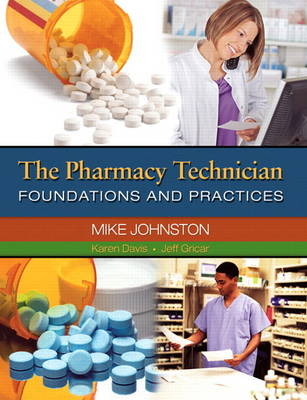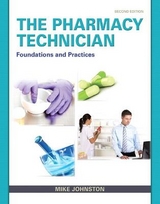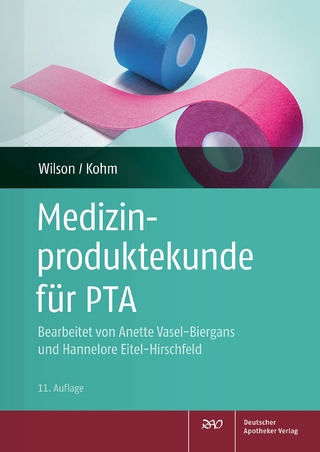
The Pharmacy Technician
Pearson (Verlag)
978-0-13-228309-0 (ISBN)
- Titel erscheint in neuer Auflage
- Artikel merken
Table of Contents
Preface
How to Use this Book
I. Fundamentals of Pharmacy Practice
1. History of Pharmacy Practice
Introduction
The Age of Antiquity
Ancient Man
Ancient Mesopotamia
Ancient China
Ancient Egypt
Ancient India
Ancient Greece
Ancient Rome
The Middle Ages
Monasteries
The First Apothecaries
The First Pharmacopeia
The Renaissance 1500s — 1600s
The First Anglo-Saxon Organization for Pharmacists
The First Apothecary in the American Colonies
The 18th Century
America’s First Female Pharmacist
America’s First Hospital
America’s First Apothecary General
The 19th Century
America’s First College of Pharmacy
The American Pharmaceutical Association
The Father of American Pharmacy
The United States Pharmacopoeia
The Father of Modern Genetics
The 20th Century
The American Council on Pharmaceutical Education
Evolution of the Pharmacist’s Role
Evolution of the Pharmacy Technician
The Future
Biotechnology
Pharmacogenomics
Summary
Chapter Review Questions
Critical Thinking Questions
Web Challenge
References and Resources
2. The Professional Pharmacy Technician
Introduction
Overview of the Pharmacy Profession
Educational Requirements
Roles of Pharmacy Professionals
Practice Settings
Characteristics of a Good Pharmacy Technician
Display a Professional Manner and Image
Demonstrate Initiative and Responsibility
Work as a Team Member
Adapt to Change
Enhance Skills and Knowledge through Continuing Education and Professional Development
Treat Patients with Compassion and Empathy
Preparing for Your Future as a Pharmacy Technician
Registration/Licensure for the Pharmacy Technician
Certification for the Pharmacy Technician
Professional Organizations
Career Opportunities
Summary
Chapter Review Questions
Critical Thinking Questions
Web Challenge
References and Resources
3. Communication and Customer Care
Introduction
The Communication Process
The Sender
The Message
The Receiver
Feedback
Communication Types and Methods
Verbal Communication
Written Communication
Nonverbal Communication
Barriers to Communication
Language Barriers
Communication Impairments
Defense Mechanisms
Conflict
Eliminating Communication Barriers
Caring for Customers & Patients
Patient Rights
Greeting Customers
Protecting Confidentiality
Pharmacist Consultations
Special Considerations
Summary
Chapter Review Questions
Critical Thinking Questions
Web Challenge
References and Resources
4. Pharmacy Law and Ethics
Introduction
Overview of Law
Constitutional Law
Statutes and Regulations
State Law and Regulations
Legislative Intent
Criminal, Civil and Administrative Law
Criminal Law
Civil Law
Administrative Law
Violations of the Law
Regulatory Agencies
Centers for Medicare and Medicaid Services
Drug Enforcement Administration
Food and Drug Administration
Joint Commission on Accreditation of Healthcare Organizations
Occupational Safety and Health Administration
State Board of Pharmacy
Overview of Pharmacy Law
State and Federal Functions
The Pure Food & Drug Act of 1906
The Food, Drug and Cosmetic Act of 1938
The Durham-Humphrey Amendment of 1951
The Kefauver-Harris Amendment of 1962
The Comprehensive Drug Abuse Prevention & Control Act of 1970
The Poison Prevention Packing Act of 1970
The Occupational and Safety Health Act of 1970
The Drug Listing Act of 1972
The Medical Device Amendment of 1976
The Orphan Drug Act of 1983
The Drug Price Competition and Patent Term Restoration Act of 1984
The Prescription Drug Marketing Act of 1987
The Anabolic Steroids Act of 1990
The Omnibus Budget Reconciliation Act of 1990
The Dietary Supplement Health & Education Act of 1994
The Health Insurance Portability and Accountability Act of 1996
The Combat Methamphetamine Epidemic Act of 2005
Adulteration versus Misbranding
Adulterated Drugs
Misbranded Drugs
New Drugs
Samples
Medical Devices
Monographs
Description
Clinical Pharmacology
Indications and Usage
Contraindications
Warnings
Precautions
Drug Abuse and Dependence
Adverse Reactions
Dosage
How Supplied
Ethics and the Pharmacy Technician
Defining Ethics
Moral Philosophy
Practicing Ethics
Ethical Theories
Consequentialism
Nonconsequentialism
Social Contracts
The Ethics of Care
Rights-Based Ethics
Principle-Based Ethics
Virtues-Based Ethics
Law
Professional Code of Ethics
The Pharmacy Technician Code of Ethics
Summary
Chapter Review Questions
Critical Thinking Questions
Web Challenge
References and Resources
5. Terminology and Abbreviations
Introduction
Understanding Selected Roots
Understanding Selected Prefixes
Understanding Selected Suffixes
Understanding Combining Forms
Pharmacy Abbreviations
Dangerous Abbreviations
Terminology
Pharmaceutical Terminology
Summary
Chapter Review Questions
Critical Thinking Questions
Web Challenge
References and Resources
II. Community and Institutional Pharmacy
6. Retail Pharmacy
Introduction
Retail Pharmacy
Independent Pharmacies
Chain/Franchise Pharmacies
Retail Pharmacy Staff
Certified Pharmacy Technician
Pharmacy Clerk/Cashier
Pharmacy Manager
Doctor of Pharmacy
Pharmacist In Charge
Registered Pharmacist
Store Manager
Organization of Retail Pharmacies
OTC/Front End
Behind the Counter OTC
Prescription Drop-Off
Pharmacy Workstations
Pharmacy Counter
Storage
Pick-Up Area (Drive-Thru)
Counseling Area
Regulatory Agencies
State Board of Pharmacy
Centers for Medicare & Medicaid Services
The Prescription
Elements of the Prescription
The Patient Profile
Processing Prescriptions
Refills
Transfers
Pharmacy Technician Job Responsibilities
Over-the-Counter Medications and Pharmacy Technicians
Medical Equipment and Devices
Patient Confidentiality and HIPAA
Summary
Chapter Review Questions
Critical Thinking Questions
Web Challenge
References and Resources
7. Health System Pharmacy
Introduction
Health-System Pharmacies
Long-Term Care Facilities
Hospices
Nursing Homes
Correctional Facilities
Hospital Pharmacies
Hospital Staff
Doctor of Osteopathy
Doctor of Medicine
Physician Assistant
Certified Nursing Assistant
Licensed Nursing Assistant
Licensed Practical Nurse
Nurse Practitioner
Registered Nurse
Organization of Hospital Pharmacies
Centralized Pharmacy
Decentralized Pharmacies
Regulatory Agencies
Joint Commission on Accreditation of Healthcare Organizations
State Board of Pharmacy
Centers for Medicare and Medicaid Services
State Department of Public Health
The Policy and Procedure Manual
The Need
The Benefits
The Contents
Dispensing Systems
Floor Stock
Patient Prescriptions
Unit-Dose
The Medication Order
Medication Order Components
Types of Medication Orders
Receiving Medication Orders
Processing Medication Orders
Dispensing Medication Orders
Pharmacy Technician Job Responsibilities
Record Maintenance and Management
Unit-Dose Preparation
Compounding
Repackaging
Floor Stock Inspections
Summary
Chapter Review Questions
Critical Thinking Questions
Web Challenge
References and Resources
8. Computers Applications in the Pharmacy Setting
Introduction
Computers
Hardware
Software
Computers in the Pharmacy
Automation and Robotics in Community Pharmacies
Counting Machines
Bar Coding Equipment
Prescription Filling Robots
Automation and Robotics in Health-System Pharmacies
Automated Medication Delivery Systems
Automated Storage and Retrieval Systems
Bar-Coding
Personal Digital Assistants
Telepharmacy
Pharmacy Technology and Patient Confidentiality
Summary
Chapter Review Questions
Critical Thinking Questions
Web Challenge
References and Resources
9. Inventory Management and Health Insurance Billing
Introduction
Purchasing Systems
Independent Purchasing
Group Purchasing
Methods of Purchasing
Purchasing Direct
Wholesalers
Primary Vendors
Formularies
The Ordering Process
Generate Order
Confirm Order
Submit Order
Supplier's Receipt of Order
Processing/Shipping of Order
The Receiving Process
Order Delivery
Order Verification
Inventory Adjustment
Stocking the Order
Recordkeeping
Returns
Expired Drugs
Recalls
Product Returns
Insurance Billing
Types of Insurance
Health Maintenance Organizations
Preferred Provider Organizations
Medicaid/Medicare
Worker's Compensation
Understanding the Insurance Billing Process
Insurance Terms
Collecting Insurance Data
Transmitting Prescriptions
Troubleshooting Insurance
Common Errors/Messages
Summary
Chapter Review Questions
Critical Thinking Questions
Web Challenge
References and Resources
10. Introduction to Compounding
Introduction
Overview of Compounding
Compounding a Prescription
Equipment and Supplies
Compounding Facilities
Quality Assurance
Dosage Forms and Basic Guidelines
Capsules
Powders
Lozenges and Troches
Suppositories
Solutions
Suspensions
Pastes
Creams
Gels
Ophthalmic Preparations
Otic Preparations
Nasal Preparations
Veterinary Compounding
Medication Flavoring
Psychological Impact
Flavoring Considerations
Four Taste Types
Flavoring Techniques
Coloring
Summary
Chapter Review Questions
Critical Thinking Questions
Web Challenge
References and Resources
11. Introduction to Sterile Products
Introduction
Aseptic Technique
Basic Equipment and Supplies
Laminar Flow Hoods
Vertical Flow Hoods
Needles
Syringes
IV Bags
Routes of Administration
Risks
Intravenous Administration
Sterile Products
Sterility
pH
Tonicity
Storage
Common Products
Compatibility
TPNs–Total Parenteral Nutrition
Chemotherapy
Summary
Chapter Review Questions
Critical Thinking Questions
Web Challenge
References and Resources
III. Pharmacy Calculations
12. Basic Math Skills
Introduction
Basic Math Pretest
Decimals
Decimals as Fractions
Key Points for Working with Decimals
Practice Problems 12.1
Rounding
Practice Problems 12.2
Adding and Subtracting Decimals
Practice Problems 12.3
Multiplying Decimals
Practice Problems 12.4
Dividing Decimals
Practice Problems 12.5
Roman Numerals
Rules for Roman Numerals
Practice Problems 12.6
Fractions
Proper Fractions
Improper Fractions
Simple Fractions
Complex Fractions
Rules for Calculating with Fractions
Practice Problems 12.7 — Calculating Fractions
Ratios and Proportions
Ratios
Practice Problems 12.8 Ratios as Fractions
Practice Problems 12.9 Fractions as Ratios
Practice Problems 12.10 Ratios as Percentages
Proportions
Solving for X
Practice Problems 12.11 Solving for X
Summary
Chapter Review Questions
References and Resources
13. Measurement Systems
Introduction
The Metric System
Guidelines for Metric Notation
Practice Problems 13.1
Practice Problems 13.2
International Units
Practice Problems 13.3
Milliequivalent
Practice Problems 13.4
The Apothecary System
The Avoirdupois System
The Household System
Practice Problems 13.5
Converting Measurements
Converting the Household System
Formula: Conversion of Systems
Practice Problems 13.6
Converting the Apothecary System
Practice Problems 13.7
Temperature Conversions
Practice Problems 13.9
Summary
Chapter Review Questions
Critical Thinking Questions
References and Resources
14. Dosage Calculations
Introduction
Calculating the Number of Doses
Practice Problems 14.1 — Calculating the Number of Doses
Calculating the Quantity to Dispense
Practice Problems 14.2 — Calculating the Quantity to Dispense
Calculating the Quantity of Ingredient
Practice Problems 14.3 — Calculating the Quantity of Ingredient
Calculating the Correct Days Supply
Practice Problems 14.4 — Calculating the Correct Days Supply
Solving Multiple Dosage Calculations
Practice Problems 14.5 — Solving Multiple Dosage Calculations
Calculating Pediatric Dosages
Calculating Pediatric Dosages using Fried’s Rule
Practice Problems 14.6 — Calculating Pediatric Dosages using Fried’s Rule
Calculating Pediatric Dosages using Young’s Rule
Practice Problems 14.7 — Calculating Pediatric Dosages using Young’s Rule
Calculating Pediatric Dosages using Clark’s Rule
Practice Problems 14.8 — Calculating Pediatric Dosages using Clark’s Rule
Converting Weight from Pounds to Kg
Practice Problems 14.9 — Converting Weight
Calculating Dosages using Mg/Kg/Day
Practice Problems 14.10 — Calculating Dosages using Mg/Kg/Day
Summary
Chapter Review Questions
Critical Thinking Questions
References and Resources
15. Concentrations and Dilutions
Introduction
Concentrations
Weight/Weight Concentrations
Practice Problems 15.1 — W/W Concentrations
Weight/Volume Concentrations
Practice Problems 15.2 — Weight/Volume Concentrations
Volume/Volume Concentrations
Practice Problems 15.3 -Volume/Volume Concentrations
Dilutions
Practice Problems 15.4 - Dilutions
Summary
Chapter Review Questions
Critical Thinking Questions
References and Resources
16. Alligations
Introduction
Solving Alligations
The Alligation Grid
Practice Problems 16.1
Summary
Chapter Review Questions
Critical Thinking Questions
References and Resources
17. Parenteral Calculations
Introduction
Basic Dimensional Analysis
Practice Problems 17.1 Basic Dimensional Analysis
Flow Rates
Flow Rate Duration
Practice Problems 17.2 Flow Rate Duration
Volume per Hour
Practice Problems 17.3 Volume per Hour
Drug per Hour
Practice Problems 17.4 Drug per Hour
Drop Factors
Practice Problems 17.5 Drip Rates
TPN Milliequivalents
Electrolyte Solutions
Practice Problems 17.6 Milliequivalents
Summary
Chapter Review Questions
Critical Thinking Questions
References and Resources
IV. Pharmacology
18. Dosage Formulations and Administration
Introduction
Sources of Drugs
Natural Drug Sources
Synthetic Drug Sources
Genetically Engineered Drug Sources
Drug Nomenclature
Chemical Name
Generic Name
Trade or Brand Name
Medication Errors
The Five “Rights” of Medication Administration
Types of Medication Errors
Dosage Formulations
Solid Dosage Forms
Liquid Dosage Forms
Solutions
Inhalants
Liniments
Emulsions
Suspensions
Powders
Granules
Aerosol
Extended-Release Dosage Forms
Routes of Administration
Oral
Transdermal
Inhalation
Nasal
Parenteral
Topical
Rectal
Vaginal
Ophthalmic
Otic
Summary
Chapter Review Questions
Critical Thinking Questions
Web Challenge
References and Resources
19. The Body and Drugs
Introduction
Pharmacodynamics
Receptor Complex
Site of Action
Mechanism of Action
Receptor Site
Agonists and Antagonists
The Dose-Response Curve
Half Life
Time-Response Curve
Pharmacodynamic Mechanisms
Pharmacokinetics
Plasma Concentration (Cp)
Drug Absorption
Drug Distribution
Membrane Transport Mechanisms
The Quality of Drugs — Solubility
Drugs and Their Ionization
Drug Distribution and Metabolism
The Path
Plasma Binding Protein
Absorption
Rate of Administration
Volume of Distribution
Clearance
Addiction
Characteristics of Addiction
Causes of Addiction
The Criteria for Addiction
Alcohol
Smoking Withdrawal and Cessation
Drug Dependency
Summary
Chapter Review Questions
Critical Thinking Questions
Web Challenge
References and Resources
20. Drug Classifications
Introduction
Classification of Drugs
Analgesics
Antirheumatics
Anti-infectives
Antineoplastics
Antiseptics
Cardiovascular Agents
Central Nervous System Agents
Diuretics
Endocrine and Metabolic Agents
Adrenocortical Steroids
Sex Hormones
Uterine-Active Agents
Gastrointestional Agents
Hemotological Agents
Muscle Relaxants
Nonsteroidal Anti-Inflammatory Drugs
Nutritional Agents
Respiratory Agents
Other Criteria for Drug Classification
Pregnancy Categories
Controlled Substance Categories
Over-the-Counter Drugs
Summary
Chapter Review Questions
Critical Thinking Questions
Web Challenge
References and Resources
21. The Skin
Introduction
Anatomy
Diseases and Conditions of the Skin
Rash
Eczema
Psoriasis
Skin Infections
Acne
Cellulitis
Parasitic Infestations
Tumors and Cancerous Growths
Pigmentation Disorders
Miscellaneous Skin Conditions and Diseases
Pharmaceutical Treatment of Various Skin Diseases
Summary
Chapter Review Questions
Critical Thinking Questions
Web Challenge
References and Resources
22. Eyes and Ears
Introduction
Anatomy and Physiology of the Eye
How the Eye Works
Diseases of the Eyes
Infections of the Eye and their Pharmaceutical Treatment
Stye
Blepharitis
Conjunctivitis
Eye Disorders that Affect Vision
Glaucoma
Cataract
Vascular Retinopathies
Cycloplegic Drugs, Mydriatic Drugs, and Lubricants
The Ear
Anatomy and Physiology of the Ear
Disorders and Diseases of the Ear
Complications of Earwax Buildup
Types of Hearing Loss
Conductive Hearing Loss
Sensory Hearing Loss
Drug Induced Hearing Loss
Neural Hearing Loss
Presbycusis
Otitis Media
Summary
Chapter Review Questions
Critical Thinking Questions
Web Challenge
References and Resources
23. The Gastrointestinal System
Introduction
Anatomy and Physiology of the Digestive System
Digestion
Disorders of the Digestive System
Gastroesophageal Reflux Disease
Nausea and/or Vomiting
Ulcers
Non-Steroidal Anti-inflammatory Drugs
Constipation
Nutrition
Macronutrients
Micronutrients
USDA MyPyramid Food Guidance System
Food Allergies
Summary
Chapter Review Questions
Critical Thinking Questions
Web Challenge
References and Resources
24. The Musculoskeletal System
Introduction
Anatomy of the Muscles
Muscle Action
The Bones
Bone Marrow
The Functions of Bones
Musculoskeletal Disorders
Osteomyelitis
Osteoporosis
Paget’s Disease
Treatment of Weak, Fragile, or Soft Bones
Bursitis
Tendonitis
Myalgia
Bone Marrow Disorders
Arthritis
Arthritis Treatment
Disease Modifying Anti-Rheumatic Drugs (DMARDS)
Treatment of Gout
Inflammation
Treatment for Inflammation
Skeletal Muscle Relaxants
Spastic Diseases
Multiple Sclerosis
Cerebral Palsy
Summary
Chapter Review Questions
Critical Thinking Questions
Web Challenge
References and Resources
25. The Respiratory System
Introduction
Function of the Respiratory System
Anatomy of the Respiratory System
The Diaphragm
The Lungs
Respiration
Diseases and Conditions of the Respiratory Tract
Colds
Coughs
Treatment of Allergies
Antihistamines
Mast Cell Stabilizers
Cystic Fibrosis
Asthma
Chronic Obstructive Pulmonary Disease
Emphysema
Chronic Bronchitis
Treatment Asthma and COPD
Bronchodilators
Xanthines
Anticholinergics
Anti-inflammatory Agents
Mast Cell Inhibitors
Anti-Leukotriene Drugs
Other Treatments
Summary
Chapter Review Questions
Critical Thinking Questions
Web Challenge
References and Resources
26. The Cardio, Circulatory, and Lymph Systems
Introduction
Anatomy of the Heart
Blood
Function of the Heart
The Conduction System
Diseases of the Heart
Hypertension
Congestive Heart Failure (CHF)
Ischemia
Myocardial Infarction
Arrhythmias
Treatment for Heart Disease
Cardiac Glycosides
Diuretics
Vasodilators
ACE Inhibitors
Angiotensin II Receptor Blockers
Beta-Adrenergic Blockers
Antiadrenergic Agents
Coronary Artery Disease
Treatment of Coronary Artery Disease
Antiplatelets
Anticoagulants
Tissue Plasminogen Activators
Thrombin Inhibitors
Antidotes for Overdose of Antiplatelets or Anticoagulants
Cholesterol
Triglycerides
Antihyperlipidemics
The Lymphatic System
Summary
Chapter Review Questions
Critical Thinking Questions
Web Challenge
References and Resources
27. The Immune System
Introduction
The Body’s Defense Mechanisms
Nonspecific Defense Mechanisms
Specific Defense Mechanisms
Lymphocytes
Types of Infectious Organisms
Animal Microorganisms
Virus
Plant Microorganisms
HIV/AIDS
Progression of HIV to AIDS to Death in Five Stages
HIV/AIDS Drugs
Autoimmune Diseases
Methods of Pathogenic Transmission
Antiinfectives
Antibacterials
Antifungals
Amebicides/Antiprotozoal
Antivirals
Drug Resistance
Solutions to Resistance
Vaccines
Various Infectious Disease States
Malaria
Cancer
Cancer Treatments
Drugs Used to Treat Cancer
Summary
Chapter Review Questions
Critical Thinking Questions
Web Challenge
References and Resources
28. The Renal System
Introduction
Anatomy and Physiology of the Renal System
The Nephron
The Bladder and Urine
Diseases, Conditions, and Treatments of the Urinary System
Urinary Incontinence
Urinary Retention
Urinary Tract Infections
Other Signs and Symptoms of Renal System Conditions
Kidney Stones
Edema and Hypertension
Diabetes Mellitus and the Kidneys
Diuretics
Summary
Chapter Review Questions
Critical Thinking Questions
Web Challenge
References and Resources
29. The Endocrine System
Introduction
Anatomy of the Endocrine System
Hormones
The Endocrine Glands
Hypothalamus
Pituitary Gland
Thyroid and Parathyroid
Adrenal Glands
The Nephron
Gonads
Estrogen Replacement Therapy and Menopause
Testosterone Hormonal Replacement
Side Effects of Anabolic Steroids
Androgen Precautions
Glandular Disease States
Examples of Conditions that Benefit from Endocrine Therapy
Endocrine System Disorders
Pituitary Gigantism
Pituitary Dwarfism
Acromegaly
Diabetes
Diabetes Insipidus
Abnormalities of the Adrenal Gland
Cushing’s Syndrome
Addison’s Disease
Cretinism
Myxedema (Secondary Hypothyroidism)
Grave’s Disease
Summary
Chapter Review Questions
Critical Thinking Questions
Web Challenge
References and Resources
30. The Reproductive System
Introduction
The Female Reproductive System
Anatomy
Reproductive Cycle
Hormone Contraception
Drug—Drug and Drug—Herb Interactions with Hormone Contraception
Topical Contraceptives
Contraceptive Devices
Mammary Glands and Childbirth
Female Infertility
The Male Reproductive System
Anatomy
Male Infertility
Erectile Dysfunction
Benign Prostatic Hyperplasia
Sexually Transmitted Diseases
Treatment and Prevention of STDs
Summary
Chapter Review Questions
Critical Thinking Questions
Web Challenge
References and Resources
31. The Nervous System
Introduction
Anatomy of the Nervous System
Functions of the Nervous System
The Neuron
The Peripheral Nervous System
The Central Nervous System
Spinal Cord
Brain
The Limbic System
Blood Brain Barrier
Diseases Affecting the Central Nervous System
Anxiety
Depression
Bipolar Disorder
Psychosis
Mechanism of Action of Antipsychotic Drugs
Insomnia
Hypnotics, Sedatives, and Barbiturates
Benzodiazepines
Non-Benzodiazepines Drugs
Stimulants
Adverse Actions of Stimulants
Contraindications
Withdrawal Treatment
ADHA and ADD
Stimulants Used in the Treatment of ADHD and ADD
Nonstimulants Used in the Treatment of ADHD and ADD
Convulsions, Seizures, and Epilepsy
Types and Classifications of Seizures
Status Epilepticus
Treatment of Seizures and Convulsions
Parkinson’s Disease
Pharmaceutical Treatments
Dementia
Signs and Symptoms of Dementia
Treatment of Dementia
Migraine Headaches
Classic Migraine
Common Migraine
Cancer Pain
Treatment of Cancer Pain
Nonpharmaceutical Pain Relief
Summary
Chapter Review Questions
Critical Thinking Questions
Web Challenge
References and Resources
V. Special Topics
32. Pediatric and Neonatal Patients
Introduction
Pharmacological Differences in Pediatric Patients
Drug Metabolism
Pediatric Medication Administration
Medication Errors and Pediatric Patients
Hospital Wide Action to Prevent Medication Errors
Pharmacy Actions to Prevent Medication Errors
Pharmacy Education and Communication
Common Childhood Illnesses
Respiratory Diseases
Cardiovascular and Blood Disorders
Summary
Chapter Review Questions
Critical Thinking Questions
Web Challenge
References and Resources
33. Geriatric Patients
Introduction
The Physiological Factors
Nutrition and the Presence of Disease
Disease-Drug interactions
Noncompliance
Role of the Pharmacy Technician
Dosage Forms as Related to Compliance
Polypharmacy
Medicare Part D
Summary
Chapter Review Questions
Critical Thinking Questions
Web Challenge
References and Resources
34. Introduction and Future of Biopharmaceuticals
Introduction
Biopharmaceuticals
Process of FDA Approval
Genetic Engineering
Stem cell Research
The Political Climate
Summary
Chapter Review Questions
Critical Thinking Questions
Web Challenge
References and Resources
Appendices
Appendix A: Top 200 Drugs
Appendix B: Over-the-Counter Product Guide
Appendix C: Advanced Career Path Options
Appendix D: Professional Resources
Appendix E: Referencing
Appendix F: Practice Certification Exam
Practice Certification Exam I
Practice Certification Exam II
Practice Certification Exam III
Index
| Erscheint lt. Verlag | 6.11.2008 |
|---|---|
| Sprache | englisch |
| Maße | 280 x 220 mm |
| Gewicht | 1551 g |
| Themenwelt | Medizin / Pharmazie ► Pflege |
| Medizin / Pharmazie ► Pharmazie ► PTA / PKA | |
| ISBN-10 | 0-13-228309-3 / 0132283093 |
| ISBN-13 | 978-0-13-228309-0 / 9780132283090 |
| Zustand | Neuware |
| Informationen gemäß Produktsicherheitsverordnung (GPSR) | |
| Haben Sie eine Frage zum Produkt? |
aus dem Bereich



